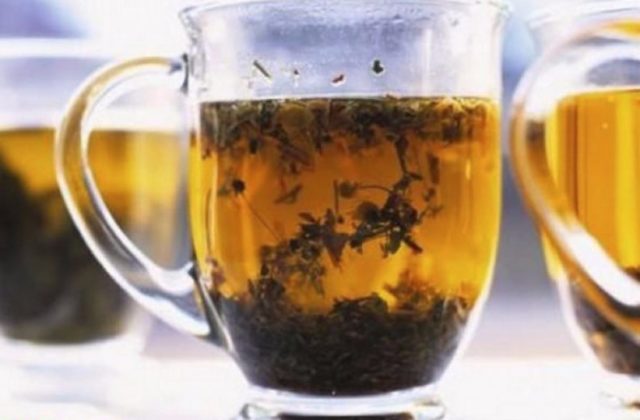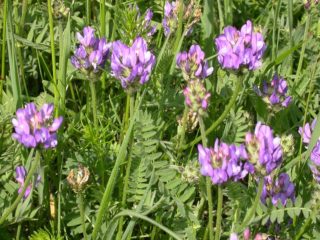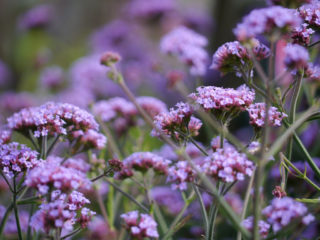Content
- 1 Botanical description of the plant
- 2 The composition and value of the plant
- 3 Healing properties of burnet
- 4 What does Burnet grass help with?
- 5 How to brew and infuse a burnet
- 6 Application features
- 7 How to take burnet
- 8 Limitations and contraindications
- 9 Collection and procurement of raw materials
- 10 Which is better: burnet or Smecta
- 11 Conclusion
- 12 Reviews on the use of burnet in gynecology
A perennial herb, the medicinal burnet is a culture that has long been used for medicinal purposes. It has a strong astringent and hemostatic effect. In the reference books of pharmaceutical plants, you can find the Latin name for the medicinal burnet - Sanguisorba officinalis. The herb is included in the domestic and European pharmacopoeias. Rhizomes with shoots are harvested as medicinal raw materials, less often the green, ground part of the culture.
Botanical description of the plant
Photos and descriptions of the medicinal burnet are contained in each reference book of medicinal plants. It is a herb consisting of a single, branched stem. It is hollow inside, ribbed outside, its height ranges from 0.5 m to 90 cm.
The stem is covered with oblong-ovate leaves, their edges are sharply serrated. Closer to the root, the leaf plate becomes larger, attaches to long petioles, from above it is smooth, dark green, from below rough, brown.

Only the roots of the burnet have a special medicinal value, and the leaves and stems are used to make tea or vitamin salads.
The flowers are oblong, spike-shaped red-purple heads, up to 3 cm long, they are located at the ends of thin erect peduncles.
The fruits are single-seeded nuts in the form of a tetrahedron, their length does not exceed 3.5 mm.
The root is located horizontally in the soil, its length does not exceed 12 cm. It is thick, woody, and has many thin fibrous processes.
The medicinal crop grows in meadows (dry and flooded), in the steppes, in sparse forests. It can be found in clearings and along the edges, along the edges of cliffs, in dense bushes, on river banks and swamps.
Why is the burnet so called
The Latin name of the culture can be translated as "consuming blood". This is due to the ability of meadow grass to stop bleeding. This characteristic is due to the presence of a large amount of tannins in the rhizome of the burnet.
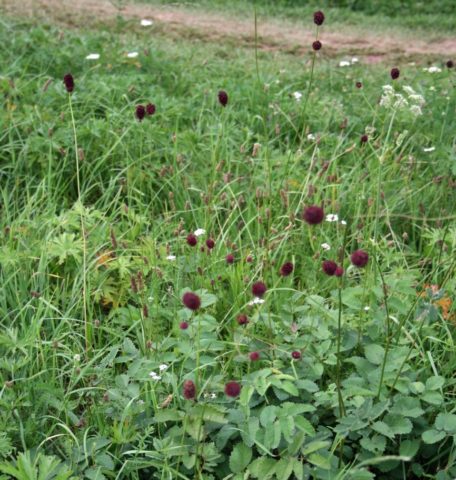
In the wild, the pharmacy burnet is widespread practically throughout the territory of Russia.
The composition and value of the plant
The roots of the culture contain tannins, up to a quarter of the total composition, 30% starch, essential oils, saponins.
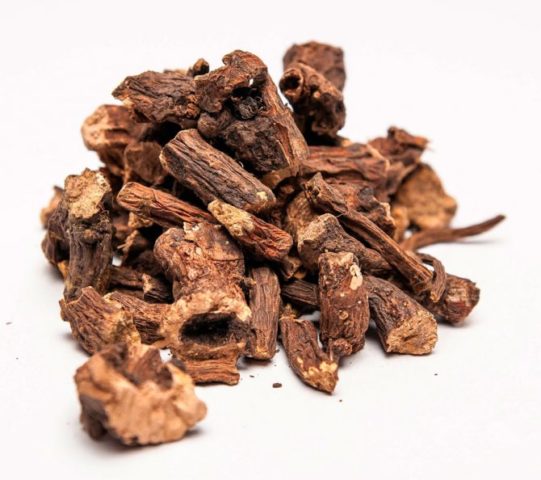
Dried, crushed burnet root after cooking will help with a variety of gastric and gynecological diseases
The green part of the plant contains flavonoids, tannins, acids (ursolic, tormentic, chlorogenic). Ascorbic acid was found in the leaves.
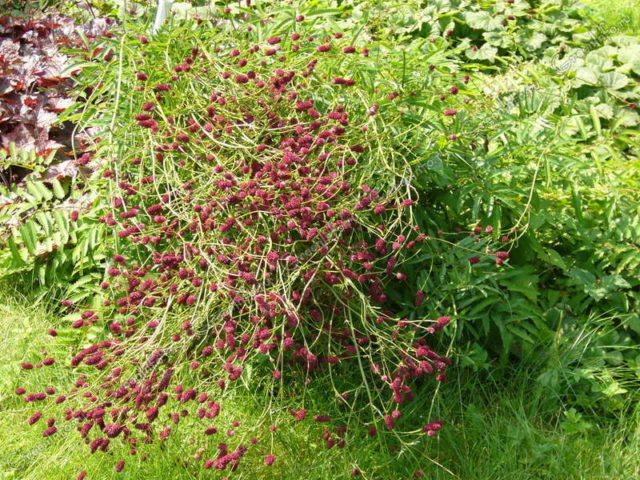
The meadow plant is listed in the Red Book in many countries, it can be easily cultivated in your own garden.
Healing properties of burnet
Burnet medicinal is highly astringent, hemostatic, analgesic properties. The herb has a bactericidal effect against Escherichia coli, organisms of the dysentery and paratyphoid group.
Burnet medicinal is able to reduce intestinal peristalsis, narrow blood vessels, increase uterine contraction. The plant has a slight anticonvulsant and antiemetic effect. The use of medicinal burnet and diarrhea is substantiated.
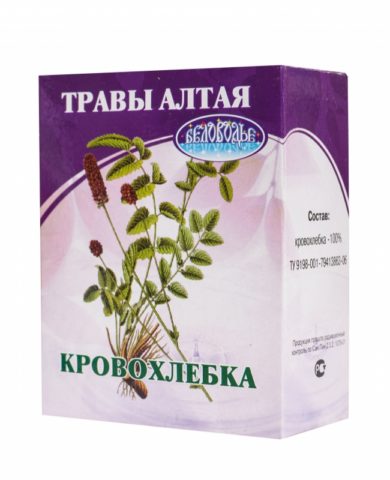
The herbal remedy has practically no contraindications, it is suitable for long course receptions
What does Burnet grass help with?
Decoctions and tinctures of the root burnet medicinal are taken for the following diseases: cholecystitis, colitis, convulsions, stomach and intestinal ulcers, it is effective for helminthic invasions.
Burnet has indications for use in children:
- with gum disease;
- stomatitis;
- acute tonsillitis;
- inflammation of the tonsils;
- diarrhea.
The external use of burnet preparations is also effective. They are used to heal ulcers, wounds, cuts and abrasions, bruises, bruises and inflammatory skin diseases.
Adults are given it as an adjuvant for tuberculosis (with hemoptysis). The rhizome of the plant is used for the preparation of hemostatic drugs. They are effective for stomach and uterine hemorrhages, heavy menstruation.
There is evidence of the medical use and therapeutic efficacy of a decoction of the plant root for cholecystitis, colpitis, profuse discharge, chronic dysentery, as well as for various intestinal pathologies accompanied by bloating.
In addition to medicinal properties, burnet grass also has a number of contraindications: constipation, pregnancy, lactation, increased blood clotting, thromboembolism, individual intolerance.
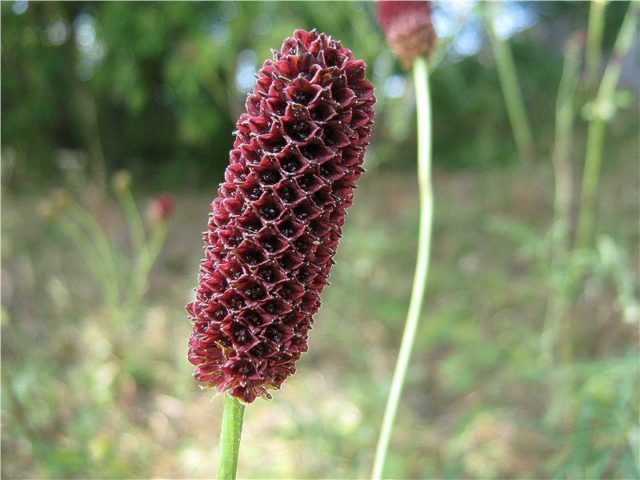
Depending on the disease, various forms of burnet-based preparations are shown.
How to brew and infuse a burnet
Depending on the type of medicine and the disease, the method of brewing medicinal burnet changes. Before using each, a doctor's consultation is required.
Decoction
For the preparation of the composition, enamel dishes are used. Put 2 tbsp in a small container. l. dry crushed roots of the burnet, pour a glass of boiling water. The saucepan is put on low heat, the contents are simmered for half an hour.
The broth is not contraindicated even for small children, for infants it is given for diarrhea in the form of drops, for older children ½ tsp.
Infusion
This drug is prepared in a cold way. Mix 3 tsp in a small container. dry grass and two glasses of settled or filtered water. The liquid is infused for eight hours, then drunk as directed by a doctor.
Tincture
This drug is prepared using alcohol. In a glass, dark container, put part of the dry roots of the medicinal burnet. They are poured with five parts of 40% alcohol. The mixture is infused for a week.
Tea
2 tsp herbs are poured with a glass of cold water. The mixture is brought to a boil, set aside. Tea is infused for 10 minutes, filtered, drinking two cups a day.
Application features
In folk medicine, a decoction of the medicinal burnet is used for diarrhea, hemoptysis, and bleeding. Outwardly, the agent is used as a lotion for purulent wounds, ulcers, bedsores.
The use of medicinal burnet in gynecology
Meadow grass remedies are often used in folk medicine for “female diseases”. The herb is effective for uterine bleeding, heavy periods, endometriosis.
With uterine bleeding
Burnet grass has shown its medicinal properties in gynecology. In folk medicine, a decoction from the root with shoots is used for uterine bleeding. The product is prepared as described in the recipe above, filtered, used in 1 tbsp. l.six times a day before meals.
With heavy periods
According to reviews on women's forums, the burnet has worked well for uterine bleeding during menstruation. With this ailment, hot tea is prepared: 2 tsp. dry roots are poured with a glass of boiling water, allowed to settle for ten minutes, cooled. The remedy is taken half a glass four times a day.
After cleansing endometriosis
One of the indications for the use of burnet in gynecology is the postoperative period. At this time, it is recommended to drink a strong decoction from the rhizome of the herb. It is prepared like this: ½ tsp. raw materials are poured with a glass of cold water, insisted for eight hours. After the product is boiled, filtered. It is taken warm in 2-3 tbsp. l. every time after a meal.
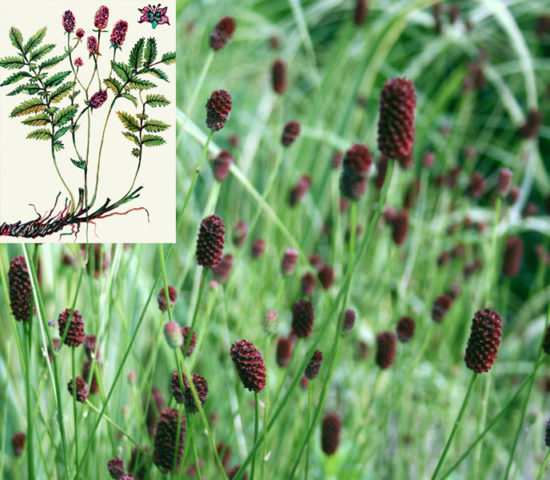
The medicinal herb has a symptomatic effect, it also quite successfully affects endometrial atrophy.
With inflammation
In gynecology, medicinal burnet is used for Trichomonas inflammation of the vagina, profuse leucorrhoea. Prepare a strong broth with a volume of 1.5 liters, cool it. Douching is carried out with a warm agent at night.
With fibroids
In this case, you can use an alcoholic tincture of medicinal burnet. Before use, it is diluted with warm water in the ratio: 1 tbsp. l. drug for 250 ml of liquid. Take 1-2 tbsp. l. the drug three times a day after meals.
For lesions and skin diseases
A decoction of the herb burnet medicinal is also effective when used externally. Lotions, compresses, wet rubdowns are made from it. The product is effective when warm. They impregnate it with a clean cloth or gauze folded in several layers, then apply it to the affected area. Applications are carried out twice a day.
For eczema, Korean doctors recommend making an ointment from the roots of the burnet. The underground part of the plant is roasted over a fire until it becomes coals. Then it is ground into powder, mixed with petroleum jelly in a ratio of 3: 7. The affected areas of the skin are lubricated with the product twice a day for a week.
With hemorrhoids
In the period of exacerbation of hemorrhoids, a decoction from medicinal burnet will also help. Prepare enough of it to fill the basin by at least a third. The liquid should be slightly warm. Baths are taken in a sitting position at night.
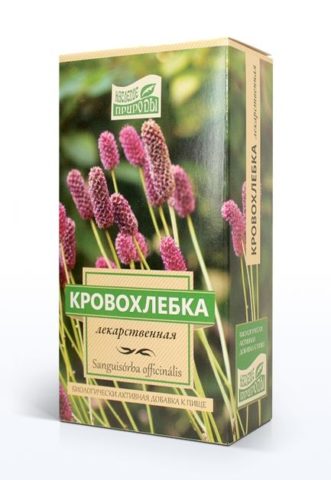
You cannot use a hot mixture for hemorrhoids, this leads to an exacerbation of the disease
With diarrhea
With intestinal disorders, a decoction of medicinal burnet will help. It is prepared according to the recipe described above. The cooled product is drunk in 1 tbsp. l. six times a day 30 minutes before meals.
From lamblia
In this case, a decoction of the rhizomes of the medicinal burnet is used. Treatment is carried out in courses of 3-8 times with a break per month. 100 ml of fresh warm broth is poured through a duodenal tube once a day.
With bronchitis
In case of bronchial disease, tea from the herb of the medicinal burnet is prescribed. It is drunk three times a day after meals for a week.
From worms
To remove small helminths, a tea made from a mixture of rhizomes and herbs of the medicinal burnet is recommended. 2 tsp collection is steamed with a glass of boiling water, insisted for 10-15 minutes. After taking a glass of funds twice a day before meals.
How to take burnet
In moderate doses, with short-term use (no more than two months), burnet does not have any negative effect on health. In rare cases, minor side effects can be observed: allergic reactions, disorders of the digestive system.

Rarely, ingestion of herbal infusions from burnet leaves leads to the development of cutaneous allergic reactions
Indications for the use of medicinal burnet:
- acute and chronic diseases of the gastrointestinal tract, accompanied by diarrhea;
- heavy menstrual bleeding;
- minor bleeding in the post-coagulation period of treatment of the cervix.
Decoctions, infusions, teas are recommended to be prepared before each meal. The product must be drunk warm, filtered and shaken.
Pharmacy filter bags with the collection of burnet are brewed strictly according to the instructions, used according to the doctor's prescription.
Can I give to children
The plant is not toxic, it can be drunk by children over a year old Burnet medicinal in liquid form is prescribed for babies with diarrhea. Prepare a decoction: take 1 tsp. chilled remedy, give the child to drink twice a day before meals. You can rinse your throat with a warm remedy for tonsillitis.
When treating a child with decoctions and teas with medicinal burnet, the age and weight of the baby are taken into account. First, you need a consultation with your attending pediatrician.
When treating babies, it is important not to exceed the recommended dosage of any herbal medicine.
Can i take during pregnancy and hepatitis B?
During pregnancy and lactation, it is not recommended to take medications based on burnet. All drugs are used only after consulting a doctor.
Limitations and contraindications
Burnet root has undoubted medicinal properties, but there are a number of contraindications to the use of funds based on it.
You can not use decoctions with burnet for the treatment of such categories of persons:
- pregnant women;
- nursing mothers;
- children under one year old;
- people suffering from constipation;
- allergy sufferers.
The drug is prescribed with caution in case of increased blood clotting, thromboembolism (in history).
There were no categorical contraindications for using burnet.
In case of internal gastric or uterine bleeding, it is necessary to find out the cause of the phenomenon, in consultation with a doctor.
Collection and procurement of raw materials
You can find burnet grass in wet meadows, on the edges of forests, among bushes. In folk medicine, the rhizome of the medicinal burnet is used to treat various ailments. It is harvested at the end of August, at the beginning of September. You can dig up a healing root in the spring, if you know its exact location.
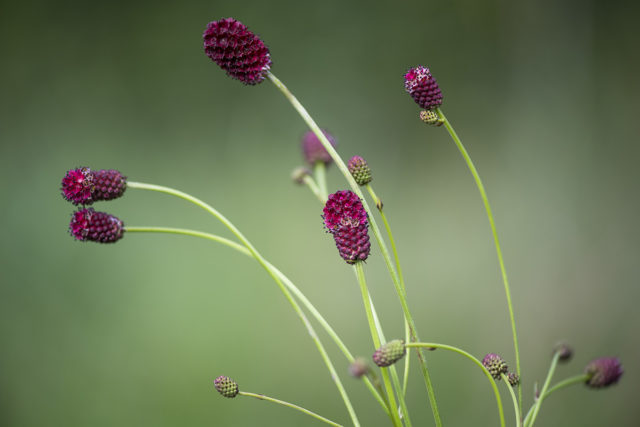
The roots are collected in ecologically safe areas, it is strictly forbidden to harvest raw materials near the roads
The roots extracted from the soil are thoroughly cleaned, washed in running water, cut into bushes no longer than 20 cm. Then they are laid out in an even layer on a clean cloth. The raw materials are dried for several days in the shade.
To avoid mold growth, the roots are often turned over, drying from all sides. After preparatory measures on the outside, they become black-brown, yellow at the break.
You can harvest the rhizome of medicinal burnet and in thermal dryers. Moreover, the temperature in them should not exceed + 50 ᵒС. The finished dried raw materials are stored in cardboard boxes for five years.
In folk medicine, the ground part of the medicinal burnet is also used. Grass harvesting begins during the flowering period. It's mid-summer.
Which is better: burnet or Smecta
With diarrhea caused by rotavirus intestinal infection, or banal food poisoning, Smecta is often prescribed as an adjuvant. The powder can be given to adults and children. Burnet medicinal decoction is also unlimited in appointment by age range.
Burnet quickly relieves symptoms, stops diarrhea, but it is drunk in courses. After which the remedy can provoke constipation.
Smecta is a fast-acting antidiarrheal drug, it is not necessary to drink it in courses.

On the way or at work, it is convenient to use a small bag of Smekta, and the burner can only be used at home
In addition to astringent properties, meadow grass also has hemostatic, bactericidal, antiseptic effects.Smecta's work is aimed only at establishing a chair.
Conclusion
Burnet medicinal is a meadow herb, known since ancient times for its beneficial properties. The villagers used the culture not only for medicinal purposes, but also for fodder for livestock, as a melliferous and tanning plant. Young fresh leaves of the herb are rich in ascorbic acid; in spring they can be used as a vitamin supplement in vegetable salads. Burnet is widely used as an antidiarrheal and hemostatic agent. Dried root sachets are available at the pharmacy. The package contains detailed methods for the preparation and use of the drug for various diseases.
